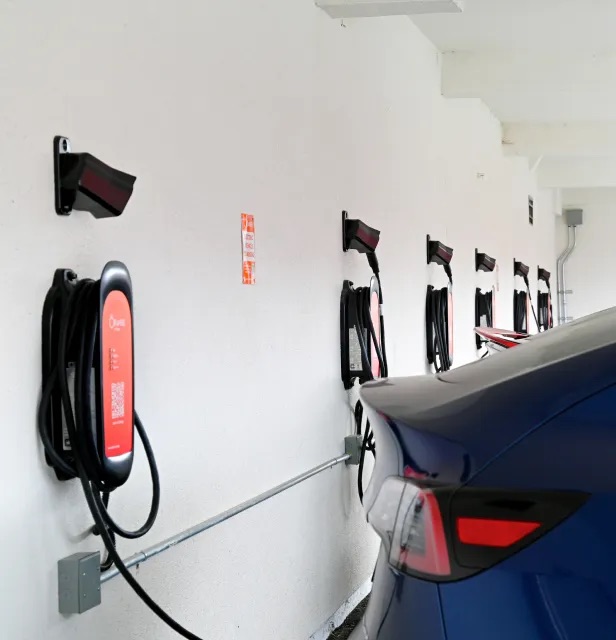An electric vehicle owner with a driveway can buy a 50-amp outlet for $10 and find DIY instructions on YouTube or hire someone to install it for a few hundred bucks.
Unfortunately, for garage owners and multifamily and office landlords to provide EV charging for tenants, it’s far more complicated and expensive.
It is often necessary to upgrade a building’s electrical system, which can run well into the six figures, and parking spots will typically need a charger and networking equipment, not just an outlet, to monitor usage and bill for it.

Installation and permits might run up $7,000 or more per charger, and maintenance costs tend to be high, according to former Tesla engineer Nicholas Johnson.
“One of the main problems for chargers is they break,” he said. “Someone runs over the cable, or the cable gets stolen.”
Johnson’s Orange Charger and other companies are competing for landlords’ business, which is growing as more localities require EV chargers and more tenants request them.
One option for building owners is to outsource charging, as Related Companies did with Gravity at Manhattan Plaza, 401-471 West 42nd Street in Midtown. Many utilities, including Con Ed, offer incentives. (More information follows this article.)
Landlords know most cars will eventually be electric and EV owners will frown on apartment buildings that don’t have enough charging stations. Structured parking at Class A offices will be considered outdated if employees can’t charge their cars while at work.

Charging stations can be a money-maker for landlords, but Johnson noted, “Some property owners just want to break even. They don’t want to lose tenants because they don’t provide the amenity.”
Of the 1,016 parking structures in New York City that have submitted data to the Department of Buildings, 324 have spaces with EV charging stations — 1,809 chargers in all. Most of the city’s more than 5,000 parking structures have not filed reports because they are not due yet.
New York is among a number of cities that have passed laws mandating EV chargers, or charger readiness, in parking garages and lots. New York’s Local Law 55, which passed in March, applies to garages and lots that have 10 or more spaces and are licensed by the Department of Consumer and Worker Protection.
The law mandates that by 2035, in existing lots and garages, 20 percent of parking spaces have Level 2 EV chargers and 40 percent must be charger-ready. In new lots and garages, and existing ones that undergo significant alterations, 20 percent of spaces must have chargers and 60 percent must be EV-ready.
The effective date of the law won’t be official until the city enacts Intro 436, a bill to update the electric code. It has had a hearing but not a vote.
New York’s real estate industry hasn’t made a fuss about the law because its deadlines are a long way off and garages were heading in that direction anyway.
Local Law 55 also has some flexibility: A single Level 3 charger — the ultra-fast kind — can be counted as 10 Level 2 chargers. “That helps you play with the math of the 20 percent goal,” noted Vinod Palal, a principal and senior electrical engineer at Goldman Copeland, a New York City-based consulting engineering firm.
But installing EV chargers is no small task, he said.
“It is a major electrical infrastructure upgrade in several facets,” said Palal. “The first thing you want to determine is, Is the electrical service coming into the building adequate? If the answer is no, the utility may want to bring in a separate service and that may be a deal-breaker. That’s very costly.”
Johnson, who launched his startup in 2020, recalled an Oakland development that stalled because the power company couldn’t provide enough electricity for a 200-car lot without upgrading its substation, which would take years.

“It was literally impossible to build the building because they couldn’t get the power to meet code for charging,” he said.
Orange Charger pitches customers a Goldilocks solution: chargers that are not fast, but fast enough, and economical.
“A lot of people were putting in more power than they needed,” he said. “We’re able to install for a lot less than the traditional Level 2 charger.”
Drivers using Orange’s chargers might be able to add 115 miles overnight rather than 300, but Johnson notes that drivers in the U.S. typically only travel 40 miles per day.
“When you have that lower power charger, you save on the copper itself,” he said, referring to the smaller-gauge wire needed. “I think this is lost a little bit on developers.”
A lot of his customers are landlords of apartment complexes in California, where, he said, it seems like “every other car” is electric. So it makes sense to have a lot of slow chargers rather than ask a lot of drivers to share a few fast ones.
“By doing that, we’re able to charge more cars,” Johnson said. “We avoid what we call musical cars. Nobody wants to wake up at midnight to swap their cars out.”
* * *
Looking to install EV chargers? Start by contacting the local utility. In New York City, Con Edison has an incentive program and dedicated team for this, including an E-Mobility Advisory Service for early questions like how much capacity is available at a property.
Once owners have an idea of what they want, they submit engineering documents showing how much load they are installing, a rough idea of the site layout, and a one-line electrical drawing.
From there, owners can register for Con Ed’s PowerReady incentive program and submit an application. The utility then does an eligibility check before connecting applicants with its Energy Services group, which reviews the documents and does a load study that takes 30 or 40 days.
The incentive program has supported the installation of nearly 9,000 Level 2 and over 400 DCFC plugs citywide. The program offsets some of the infrastructure cost, but does not pay for the chargers.
For a project adding 25 Level 2 chargers for apartment building residents, for example, Con Ed can pay for half of the infrastructure cost, up to $7,500 per charger. If the chargers are available to the public, it can cover up to 90 percent, capped at $13,500 per plug. Incentives for DCFC fast chargers are also available.
About $100 million of funding remains and according to Con Ed, it’s going fast.
Read more



